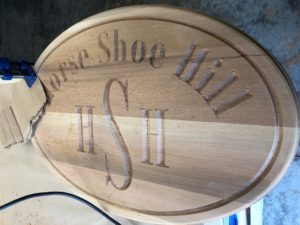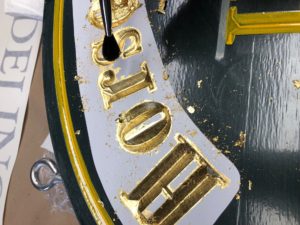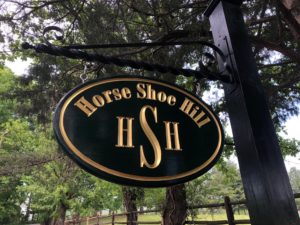 Applying Gold Leaf to Carved Signs
Applying Gold Leaf to Carved Signs
ATTENTION-GETTER NEEDED
Applying gold leaf to carved signs is a great way to garner attention and give your signage a look of elegance and help add a look of sophistication to your home, office or entrance. I was recently hired to make a small carved wood sign for a horse farm that would replace the existing entrance sign. The original sign was in the same size range but was made of painted plywood and had a white background with black lettering. The old sign’s shape was rectangular but the customer wanted an oval shape that matched a wood sign system she had seen in Charlottesville, Virginia.
There are many commercial sign shops in the Shenandoah Valley area of Virginia where Augusta Sign Company is located, but there are few who can create durable signs in carved wood.
GO FOR THE GOLD
The customer wanted to know the cost of adding gold leaf letters instead of just plain, painted letters, and after I presented my proposal, she elected to go for the gold! Gold leaf is an ancient art form. “The Temple of Solomon was profusely gilt,” says Homer in his early writings. Gold leaf was widely used in old Roman art, architecture, furniture, and carved lettering. Gold leaf is actual gold that is beaten down to a fine sheet and applied to surfaces with “size”, a special type of “glue” that the thin metal sheets stick to. To make the sign for the horse farm, I first ordered the cedar panel and had the letters and borders CNC-routed from my customer-approved design. Once the letters and borders were carved, I sanded them with fine-grit sandpaper to smooth out any course grain in the lettering. Once sanded, I cleaned and primed the entire two-sided sign with a quality oil-based primer that seals the wood and provides an adequate base for the finish coat, which in this case was a brush-painted Hunter Green sign enamel. It helps to tint your primer to the shade of your finish coat, so I added some black tint to make a gray primer coat. I use the 2-2-2 method in my finishing of wood signs: 2 coats primer, 2 coats background finish, and 2 coats for the graphics, which for this project meant two passes of gilding to catch any missed areas and pinholes.
presented my proposal, she elected to go for the gold! Gold leaf is an ancient art form. “The Temple of Solomon was profusely gilt,” says Homer in his early writings. Gold leaf was widely used in old Roman art, architecture, furniture, and carved lettering. Gold leaf is actual gold that is beaten down to a fine sheet and applied to surfaces with “size”, a special type of “glue” that the thin metal sheets stick to. To make the sign for the horse farm, I first ordered the cedar panel and had the letters and borders CNC-routed from my customer-approved design. Once the letters and borders were carved, I sanded them with fine-grit sandpaper to smooth out any course grain in the lettering. Once sanded, I cleaned and primed the entire two-sided sign with a quality oil-based primer that seals the wood and provides an adequate base for the finish coat, which in this case was a brush-painted Hunter Green sign enamel. It helps to tint your primer to the shade of your finish coat, so I added some black tint to make a gray primer coat. I use the 2-2-2 method in my finishing of wood signs: 2 coats primer, 2 coats background finish, and 2 coats for the graphics, which for this project meant two passes of gilding to catch any missed areas and pinholes.
WAXING GLOW
 Once the gold was applied and cured for several days, I burnished it with a cotton ball and completely waxed the entire sign using Nu-Finish synthetic auto wax, available in most auto parts stores. The post was constructed from a 6″ X 6″ X 13′ long Southern Yellow Pine column with a beefed-up area at the bottom of the post, suggested by my customer’s architect. The sign post was colored black to match the black iron scroll bracket, which was a stock item from my supplier. I used stainless steel eye-bolts and quick links to attach the sign to the bracket. The sign was planted in a 3 foot deep hole and surrounded with fast set concrete.
Once the gold was applied and cured for several days, I burnished it with a cotton ball and completely waxed the entire sign using Nu-Finish synthetic auto wax, available in most auto parts stores. The post was constructed from a 6″ X 6″ X 13′ long Southern Yellow Pine column with a beefed-up area at the bottom of the post, suggested by my customer’s architect. The sign post was colored black to match the black iron scroll bracket, which was a stock item from my supplier. I used stainless steel eye-bolts and quick links to attach the sign to the bracket. The sign was planted in a 3 foot deep hole and surrounded with fast set concrete.
I appreciate opportunities to make signs with gold leaf, and have done my share of them over the years. I learned this specialized art during my career as a sign painter at Andrews Air Force Base in the early 1980’s, and received extra training in the early 1990’s from a sign carving workshop led by expert sign carver, Jay Cooke of Stowe, Vermont. Applying gold leaf to carved signs is a specialty thing that I especially enjoy. It adds substantial cost to your project, but it provides a level of attention not doable by other sign media. If you’re interested in purchasing signs with or without gold leaf for your farm, store, or office, give me a call anytime and I’d be happy to take a look at what you have in mind.
Mark Hackley is owner of Augusta Sign Company in Staunton, Virginia. 540-943-9818